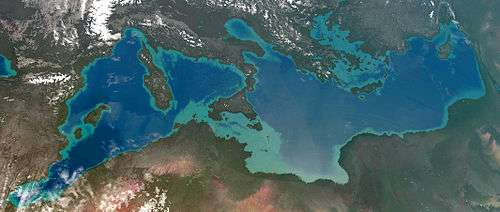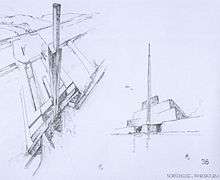Atlantropa

Atlantropa, also referred to as Panropa,[1] was a gigantic engineering and colonisation idea devised by the German architect Herman Sörgel in the 1920s and promoted by him until his death in 1952.[2][3] Its central feature was a hydroelectric dam to be built across the Strait of Gibraltar, which would have provided enormous amounts of hydroelectricity[4] and would have led to the lowering of the surface of the Mediterranean Sea by up to 200 metres (660 ft), opening up large new lands for settlement, for example in the Adriatic Sea. The project proposed four additional major dams as well:[5][6][7]
- Across the Dardanelles to hold back the Black Sea
- Between Sicily and Tunisia to provide a roadway and further lower the inner Mediterranean
- On the Congo River below its Kwah River tributary to refill the Mega-Chad basin around Lake Chad providing fresh water to irrigate the Sahara and creating a shipping lane to the interior of Africa
- Suez Canal extension and locks to maintain Red Sea connection
Sörgel saw his scheme, projected to take over a century, as a peaceful European-wide alternative to the Lebensraum concepts that later became one of the stated reasons for Nazi Germany's conquest of new territories. Atlantropa would provide land and food, employment, electric power, and most of all, a new vision for Europe and neighbouring Africa.
The Atlantropa movement, through its several decades, was characterised by four constants:[8]
- Pacifism, in its promises of using technology in a peaceful way;
- Pan-European sentiment, seeing the project as a way to unite a war-torn Europe;
- Eurocentric attitudes to Africa (which was to become united with Europe into "Atlantropa" or Eurafrica), and
- Neo-colonial geopolitics, which saw the world divided into three blocs—America, Asia and Atlantropa.[9]
Active support was limited to architects and planners from Germany and a number of other primarily northern European countries. Critics derided it for various faults, ranging from lack of any actual cooperation of Mediterranean countries in the planning to the impacts it would have had on the historic coastal communities left stranded inland when the sea receded. The project reached great popularity in the late 1920s/early 1930s, and for a short period again, in the late 1940s/early 1950s, but soon disappeared from general discourse again after Sörgel's death.[10]
Project


The plan was inspired by the then-new understanding of the Messinian salinity crisis,[11] a pan-Mediterranean geological event that took place 5 to 6 million years ago.[12] The contemporary geologists proposed that the large salt deposits surrounding the Mediterranean coast were the result of its partial isolation by a shrinking of the seaways connecting to the Atlantic. Today it is a majority opinion among geoscientists that the Mediterranean underwent a significant drawdown during that period, of at least a few hundred meters.[13]
The Utopian goal was to solve all the major problems of European civilisation by the creation of a new continent, "Atlantropa", consisting of Europe and Africa and to be inhabited by Europeans. Sörgel was convinced that to remain competitive with the Americas and an emerging Oriental "Pan-Asia", Europe must become self-sufficient, and this meant possessing territories in all climate zones. Asia would forever remain a mystery to Europeans, and the British would not be able to maintain their global empire in the long run—hence a common European effort to colonise Africa was necessary.[14] The lowering of the Mediterranean would enable the production of immense amounts of electric power, guaranteeing the growth of industry. Unlike fossil fuels, this power source would not be subject to depletion. Vast tracts of land would be freed for agriculture—including the Sahara desert, which was to be irrigated with the help of three sea-sized man-made lakes throughout Africa. The massive public works, envisioned to go on for more than a century, would relieve unemployment and the acquisition of new land would ease the pressure of overpopulation, which Sörgel thought were the fundamental causes of political unrest in Europe. Sörgel also believed the project's effect on the climate could only be beneficial.[15] Sörgel believed that the climate could be changed for the better as far away as the British isles due to a more effective Gulf Stream creating warmer winters.[16] The Middle East under the control of a consolidated Atlantropa would be an additional energy source and a bulwark against the so called Yellow Peril.[17]
The publicity material produced for Atlantropa by Sörgel and his supporters contain plans, maps, and scale models of several dams and new ports on the Mediterranean, views of the Gibraltar dam crowned by a 400-metre tower designed by Peter Behrens, projections of the growth of agricultural production, sketches for a pan-Atlantropan power grid, and even provision for the protection of Venice as a cultural landmark.[18] Concerns about climate change or earthquakes, when mentioned, were framed as positives rather than negatives.[16] Sörgel's 1938 book Die Drei Grossen A has a quote from Hitler on the flyleaf, demonstrating that the concept was not inconsistent with Nazi ideology.
After the Second World War, interest was piqued again as the Western Allies sought to create closer bonds with Africa and combat communism, but the invention of nuclear power, the cost of rebuilding, and the end of colonialism left Atlantropa technologically unnecessary and politically unfeasible, although the Atlantropa Institute remained in existence until 1960.[18]
Most proposals to dam the Strait of Gibraltar since that time have focused on the hydroelectric potential of such a project, and do not envisage any substantial lowering of the Mediterranean sea level. A new idea involving a tensioned fabric dam stretched between Europe and North Africa in the Gibraltar Strait is envisioned to cope with any future global sea-level rise outside of the Mediterranean Sea Basin.[19]
See also
References
- ↑ Hanns Günther (Walter de Haas) (1931). In hundert Jahren. Kosmos.
- ↑ "GERMAN GENIUS". Advocate. LXII, (3956). Victoria, Australia. 13 June 1929. p. 36. Retrieved 20 August 2017 – via National Library of Australia.
- ↑ "No title". The Week (Brisbane). CXII, (3, 001). Brisbane, Queensland, Australia. 28 June 1933. p. 20. Retrieved 9 February 2018 – via National Library of Australia. , ...The Munich architect, Hermann Soergel, has published his gigantic project "Atlantropa," a . scheme which he has been supervising for six years, which by lowering the level of the Mediterranean, he contends, will water the Sahara desert, win new land and connect Europe and Africa. This is one of the drawings belonging to his exhibition...
- ↑ "Atlantropa: A plan to dam the Mediterranean Sea.""16 March 2005. Archive. Xefer. Retrieved on 4 August 2007.
- ↑ Ley, Willy (1959). Engineers' Dreams: Great projects that could come true. Viking Press.
- ↑ lord_k. "The Atlantropa Project". Dieselpunks.org. Retrieved 2013-08-13.
- ↑ Bellows, Jason (2008-09-25). "Mediterranean be Dammed". Retrieved 2013-08-13.
- ↑ Voigt, Wolfgang (1998). Atlantropa - Weltenbauen am Mittelmeer (in German). p. 100. ISBN 978-3-86735-025-9.
- ↑ Politische Geographien Europas: Annäherungen an ein umstrittenes Konstrukt, Anke Strüver, LIT Verlag Münster, 2005, p. 43
- ↑ Voigt, Wolfgang (1998). Atlantropa - Weltenbauen am Mittelmeer (in German). p. 122. ISBN 978-3-86735-025-9.
- ↑ Krijgsman, W.; Garcés, M.; Langereis, C.G.; Daams, R.; Van Dam, J.; Van Der Meulen, A.J.; Agustí, J.; Cabrera, L. (1996). "A new chronology for the middle to late Miocene continental record in Spain". Earth and Planetary Science Letters. 142 (3–4): 367–380. Bibcode:1996E&PSL.142..367K. doi:10.1016/0012-821X(96)00109-4. Retrieved 2008-03-01.
- ↑ Gautier, F., Clauzon, G., Suc, J.P., Cravatte, J., Violanti, D., 1994. Age and duration of the Messinian salinity crisis. C.R. Acad. Sci., Paris (IIA) 318, 1103–1109.
- ↑ Garcia-Castellanos, D.; Villaseñor, A. (2011). "Messinian salinity crisis regulated by competing tectonics and erosion at the Gibraltar Arc". Nature. 480 (7377): 359–363. Bibcode:2011Natur.480..359G. doi:10.1038/nature10651. PMID 22170684.
- ↑ Sörgel, Herman. Atlantropa. Fretz & Wasmuth, Zürich 1932, p. 75 ff.
- ↑ Sörgel, Herman. Atlantropa. Fretz & Wasmuth, Zürich 1932, pp. 66–67.
- 1 2 Brock, Paul (1963-08-06). "German engineers dream of building a new continent". Detroit Free Press – via Newspapers.com.
One of the most significant advantages would be a change of climate [to that] of Northern Europe - and especially the British Isles - because the warm Gulf Stream would be rendered much more effective.
- ↑ Sörgel, Herman. Atlantropa. Fretz & Wasmuth, Zürich 1932, p. 80.
- 1 2 "Atlantropa." Issue 10 Spring 2003. Cabinet Magazine. Retrieved on 4 August 2007.
- ↑ Cathcart, R.B. Medicative Macro-Imagineering: Earth + Mars Megaprojects (March 2014), Chapter 8 pages 391–468.
Further reading
- Gall, Alexander (1998). Das Atlantropa-Projekt: die Geschichte einer gescheiterten Vision. Herman Sörgel und die Absenkung des Mittelmeers. Frankfurt a.M.: Campus. ISBN 3-593-35988-X
- Gall, Alexander (2006). Atlantropa: A Technological Vision of a United Europe, in: Networking Europe. Transnational Infrastructures and the Shaping of Europe, 1850–2000, edited by Erik van der Vleuten and Arne Kaijser. Sagamore Beach: Science History Publications, pp. 99–128. ISBN 0-88135-394-9
- Günzel, Anne Sophie (2007). Das “Atlantropa”-Projekt – Erschließung Europas und Afrikas (2nd edition). München: Grin. ISBN 3-638-64638-6
- Sörgel, Herman (1929). Mittelmeer-Senkung. Sahara-Bewässerung = Lowering the Mediterranean, Irrigating the Sahara (Panropa Project), pamphlet. Leipzig: J.M. Gebhardt.
- Sörgel, Herman (1931). "Europa-Afrika: ein Weltteil" (37): 983–987. Retrieved 2018-02-09.
- Sörgel, Herman (1932). Atlantropa. Munich: Piloty & Löhle.
- Sörgel, Herman (1932). Atlantropa (3rd, illustrated edition). Zürich: Fretz & Wasmuth.
- Sörgel, Herman (1933). Foreword to "Technokratie - die neue Heilslehre" by Wayne W. Parrish. Munich: R. Piper & Co.
- Sörgel, Herman (1938). Die drei großen "A". Großdeutschland und italienisches Imperium, die Pfeiler Atlantropas. [Amerika, Atlantropa, Asien]. Munich: Piloty & Loehle.
- Sörgel, Herman (1942). Atlantropa-ABC: Kraft, Raum, Brot. Erläuterungen zum Atlantropa-Projekt. Leipzig: Arnd.
- Sörgel, Herman (1948). Foreword to "Atlantropa. Wesenszüge eines Projekts" by John Knittel. Stuttgart: Behrendt.
- R.B. Cathcart, "Land Art as global warming or cooling antidote", Speculations in Science and Technology, 21: 65–72 (1998)
- R.B. Cathcart, "Mitigative Anthropogeomorphology: a revived 'plan' for the Mediterranean Sea Basin and the Sahara", Terra Nova: The European Journal of Geosciences, 7: 636–640 (1995).
- R.B. Cathcart, "What if We Lowered the Mediterranean Sea?", Speculations in Science and Technology, 8: 7–15 (1985).
- R.B. Cathcart, "Macro-engineering Transformation of the Mediterranean Sea and Africa", World Futures, 19: 111–121 (1983).
- R.B. Cathcart, "Mediterranean Basin-Sahara Reclamation", Speculations in Science and Technology, 6: 150–152 (1983).